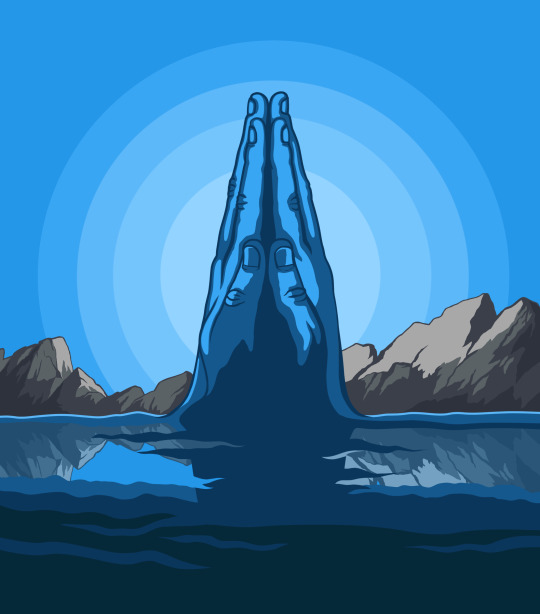#tidalpunk
Text
"The world's coral reefs are close to 25 percent larger than we thought. By using satellite images, machine learning and on-ground knowledge from a global network of people living and working on coral reefs, we found an extra 64,000 square kilometers (24,700 square miles) of coral reefs – an area the size of Ireland.
That brings the total size of the planet's shallow reefs (meaning 0-20 meters deep) to 348,000 square kilometers – the size of Germany. This figure represents whole coral reef ecosystems, ranging from sandy-bottomed lagoons with a little coral, to coral rubble flats, to living walls of coral.
Within this 348,000 km² of coral is 80,000 km² where there's a hard bottom – rocks rather than sand. These areas are likely to be home to significant amounts of coral – the places snorkelers and scuba divers most like to visit.
You might wonder why we're finding this out now. Didn't we already know where the world's reefs are?
Previously, we've had to pull data from many different sources, which made it harder to pin down the extent of coral reefs with certainty. But now we have high resolution satellite data covering the entire world – and are able to see reefs as deep as 30 meters down.

Pictured: Geomorphic mapping (left) compared to new reef extent (red shading, right image) in the northern Great Barrier Reef.
[AKA: All the stuff in red on that map is coral reef we did not realize existed!! Coral reefs cover so much more territory than we thought! And that's just one example. (From northern Queensland)]
We coupled this with direct observations and records of coral reefs from over 400 individuals and organizations in countries with coral reefs from all regions, such as the Maldives, Cuba, and Australia.
To produce the maps, we used machine learning techniques to chew through 100 trillion pixels from the Sentinel-2 and Planet Dove CubeSat satellites to make accurate predictions about where coral is – and is not. The team worked with almost 500 researchers and collaborators to make the maps.
The result: the world's first comprehensive map of coral reefs extent, and their composition, produced through the Allen Coral Atlas. [You can see the interactive maps yourself at the link!]
The maps are already proving their worth. Reef management agencies around the world are using them to plan and assess conservation work and threats to reefs."
-via ScienceDirect, February 15, 2024
#oceanography#marine biology#marine life#marine science#coral#coral reefs#environment#geography#maps#interactive maps#ai#ai positive#machine learning#conservation news#coral reef#conservation#tidalpunk#good news#hope#full disclosure this is the same topic I published a few days ago#but with a different article/much better headline that makes it clear that this is “throughout the world there are more reefs”#rather than “we just found an absolutely massive reef”#also included one of the maps this time around#bc this is a really big deal and huge sign of hope actually!!!#we were massively underestimating how many coral reefs the world has left!#and now that we know where they are we can do a much better job of protecting them
278 notes
·
View notes
Text
Lunarpunk 🌙



"Lunarpunk embraces spirituality and utopian futures, referencing witchcraft, futuristic design, nature, renewable energy, and the circle of life."
#lunarpunk#lunar#moon#space#night sky#astrology#hopepunk#ecopunk#tidalpunk#solarpunk#bioluminescence#mushrooms#art#sustainability#environmentalism#witchcraft#utopia#renewable energy#spirituality#nature#night dweller
114 notes
·
View notes
Text


Rough sketches for an idea of dual purpose covered bike and walkway, inspired by victorian and art nouveau architecture and decoration style. What do you think? :)
#solarpunk#hopecore#hopepunk#peaceful revolution#greenhorizon#anti capitalism#anti fascism#sketch#ideas#solarpunk ideas#lunarpunk#tidalpunk#climate change solutions#urban design#city planning#infrastructure#sustainability#environmentalism
60 notes
·
View notes
Text
youtube
Coral reefs around the world are threatened by rising ocean temperatures, but hope is growing off the coast of Hawaii. There, researchers at the Coral Resilience Lab selectively breed corals to withstand ever-increasing amounts of heat stress.
Corals are tiny animals that have a mutually beneficial relationship with an algae that lives within their cells. When stressed by heat, many expel their algae and turn white — known as “bleaching” — losing their main source of food and often dying within days. Half of all coral has been lost since the 1950s. But some corals do survive these bleaching events, and they’ve become the focus of Kira Hughes and her team’s work. By selectively breeding the coral that doesn't bleach, Kira hopes they can increase their resilience from one generation to the next.
To scale up their efforts, Kira’s team collects coral pieces that have naturally broken off in the ocean. With the help of volunteers, they prep and test these corals, and eventually replant the heat-tolerant corals they’ve found back into the reef they came from. This year, for the first time, the selectively bred coral “babies” will be planted too, giving the reef a fighting chance to survive the warming ocean.
#Nature on PBS#solarpunk#tidalpunk#coral reef#coral#ocean#sea#Hawaii#marine life#Coral Resilience Lab#Kira Hughes#heat resistant#Youtube
27 notes
·
View notes
Note
Hiya if you are still making reaping week moodboard I would love a Tidalpunk one with sailboats and sea steading and stuff like that! 🌊⛵️
Hell yeah!

🌱 Send an ask to get your own moodboard 🌱
#reaping week#it was so hard to find farming pictures on the water for some reason??#weird#tidalpunk#soladpunk
48 notes
·
View notes
Text
Seagrass appreciation post.
Located in the order Alismatales, related to Aroid lilies, seagrass are the only angiosperms (flowering plants) to grow and reproduce entirely in marine environments.
They are notable for the manifold ecosystem services that they provide. The human centric benefits are: That seagrass meadows sequester a hell of a lot of carbon, by creating dense root systems under the sediment - they help to reduce coastal erosion, they're a useful resource for traditional textiles or thatching roofs and the like.
For their ecosystems, however, they;
Reduce the turbidity of water, to the benefit of all photosynthesising organisms in the marine environment.
Provide habitat for fish, invertebrates and microorganisms. They're also known to be frequented by sea turtles, sirenians and mute swans.
Are excellent nurseries for predominantly pelagic species by providing an area inaccessible for pelagic predators.
Interesting and quirky biology
To adapt to marine environments, seagrasses have had to adapt in some weird ways.
They've lost their stomata entirely (pores that help in gas exchange), a porous layer of cells allows C02 to diffuse into the leaves instead.
Membranes in the cell walls can open when osmotic pressure is high, letting water flood in to restore the cell to regular pressure.
Pollen is released by the stamens in sticky, gelatinous clumps
Conclusion
Seagrasses= V cool. Thanks.
7 notes
·
View notes
Text
Solarpunk Spirituality - An Introduction
When I found solarpunk I loved how the movement embraced both the scientific and the spiritual. This year we'll have several contributors presenting their own experiences with #solarpunk, #lunarpunk, and the #spiritual.
#spirituality #betterworld
Photo by stein egil liland on Pexels.com
We’ve talked about solarpunk, lunarpunk, and tidalpunk a great deal here, and one question I hear repeated is whether we need three different subgenres or if there are sharp distinctions between them at all. For me, solarpunk, lunarpunk, and tidalpunk each embody the same values of ecology and equity while expressing them in their own way. They are parts…

View On WordPress
50 notes
·
View notes
Text

This image is released under a CC BY-NC-SA license.
3 notes
·
View notes
Text

It’s frkn bats 🦇
1 note
·
View note
Text
It’s solar and wind and tidal and geothermal and hydropower.
It’s plant-based diets and regenerative livestock farming and insect protein and lab-grown meat.
It’s electric cars and reliable public transit and decreasing how far and how often we travel.
It’s growing your own vegetables and community gardens and vertical farms and supporting local producers.
It’s rewilding the countryside and greening cities.
It’s getting people active and improving disabled access.
It’s making your own clothes and buying or swapping sustainable stuff with your neighbours.
It’s the right to repair and reducing consumption in the first place.
It’s greater land rights for the commons and indigenous peoples and creating protected areas.
It’s radical, drastic change and community consensus.
It’s labour rights and less work.
It’s science and arts.
It’s theoretical academic thought and concrete practical action.
It’s signing petitions and campaigning and protesting and civil disobedience.
It’s sailboats and zeppelins.
It’s the speculative and the possible.
It’s raising living standards and curbing consumerism.
It’s global and local.
It’s me and you.
Climate solutions look different for everyone, and we all have something to offer.
#solarpunk#hopepunk#tidalpunk#cottagepunk#bright future#climate justice#environmentalism#optimism#social justice#community#solutions#pluralism#I know stuff like EVs and vertical farms get a bad rep#they are certainly overhyped and slight techbro solutions#but I think all avenues are worth exploring even if inevitably some will be less efficacious and just than others#sorry for the long tags lol
39K notes
·
View notes
Text
Probably gunna do some revamping of my Spidersona, but for now, ideas about the universe he's from.
So you know how in Ponyo the world got flooded cause of like, sea magic stuff, but got fixed? Earth-5388 is like that but it was just always that flooded. Smaller landmasses for humanity so humans developed both floating cities and underwater cities ala Rapture/where the Gunguns(?) lived on Naboo. It's very much a mix of solarpunk and tidalpunk, and also slightly eldritch. The only reason underwater/floating cities aren't attacked by like megalodons and such is because of near invisible forcefield type things that don't really hurt but are very annoying to big creatures.
1 note
·
View note
Text
A Fun Post about Solarpunk Sub-genres
Lunarpunk
Lunarpunk is the sister aesthetic to solarpunk, but darker, I was actually surprised to see it has it’s own flag presented below. The basis is people moving to the moon and waiting for the earth to heal while in colonies, there would be tons of difficulties with low gravitational pull, constant unfiltered radiation from the sun, and probably even keeping warm, very compelling in my opinion.

It looks much like the solarpunk flag, but unlike the solarpunk flag, lunarpunk doesn’t have a political movement attached
Tidalpunk
Tidalpunk is basically humans moving to the sea because the land has been left unhealed for so long, it’s almost uninhabitable, so people are living on or under the sea until the land is able to start healing again/ Expansion in population has led to housing out at or under water that’s Eco-friendly and doesn’t harm wildlife, sadly this one doesn’t have a flag. Luckily it has an aesthetic though.

Sustainable, ocean-based living? Yes please, makes me wish I knew how to swim though. To be perfectly honest I’m out of ideas on this post, so if you have any more ideas, please feel free to re-blog with what sub-genres relating to solarpunk you could find. I’m certain there are niche ones that I haven’t found yet.
As always, this has been @punkofsunshine, see ya’ll soon.
#solarpunk#lunarpunk#tidalpunk#speculative fiction#ecofiction#clifi#punk suffix#sub-genres#lunarpunk flag
270 notes
·
View notes
Text
Today’s Gender: A bioluminescent coral reef, teeming with life.


#OurLady’s portraits#transgender#asexual#genderfluid#gray-ace#lgbtq#non-binary#bisexual#ootd#outfit of the day#queer#natural hair#oceanpunk#tidalpunk#oceancore#fairycore#fairy#fae#faerie#water nymph#coral#coral nymph#ocean nymph
187 notes
·
View notes
Text
youtube
Ten years after the largest dam removal in history—on the Elwha River, in Washington State—scientists are chronicling an inspiring story of ecological rebirth. Recovering salmon populations are transferring critical nutrients from the ocean into the forests along the Elwha’s banks, enriching the entire ecosystem. The Elwha’s revival is encouraging advocates to push for the removal of many larger dams in the region, and in the rest of the world.
#Nature on PBS#wild hope#solarpunk#tidalpunk#rewilding#dam removal#river#salmon#Elwha River#Elwha#Washington#USA#indigenous#native species#Youtube
30 notes
·
View notes
Text

Bestie I'm just saying,,, @tidalpunk
#tidalpunk#solarpunk#fashion#cloaks#jewelry#canes#Pirate aes#solarpunk memes#accessible fashion#tbh I got more stuff for mobility aids and hearing aid jewelry and stuff#lots of hidden rants about using soulfarer as inspiration since it focuses on grief and beauty and peace#soulfarer
226 notes
·
View notes
Text
Plastics - A Tidalpunk Antagonist
Plastics - A Tidalpunk Antagonist
The chemical additives in #plastics negatively impact #ocean life and human health as they're eaten and move through the food chain. A #tidalpunk future will have to deal with this legacy of #waste.
Photo by Catherine Sheila on Pexels.com
Plastic pollution is one of the biggest threats to ocean life. While images of chairs and tires on the seafloor can get a visceral reaction, it’s the small stuff that will cause the biggest problems. Plastics don’t truly degrade, but break into smaller and smaller pieces until they become microplastics or microfibers. The chemical additives in these…

View On WordPress
154 notes
·
View notes